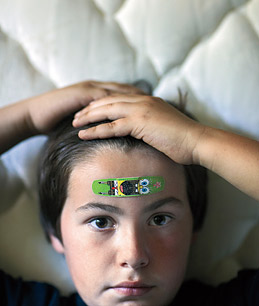
(2 of 4)
For families the questions are far more intimate and harder to reduce to balance sheets. Parents worried about the most common childhood-onset disorders — phobias, generalized anxiety, OCD, depression, bipolar disorder, attention-deficit/hyperactivity disorder, autism — rarely know exactly what to look for or what to do if they spot something. Is a child obsessive or just fastidious? Depressed or ruminative? Hyperactive or high-spirited? Overdiagnose and you may attach a stigmatizing label to a healthy child; underdiagnose and you may leave a condition to worsen on its own.
"Since you're talking about kids, whose brains change a lot over time, illnesses are simply harder to diagnose," says Dr. David Axelson, an associate professor of psychiatry and the director of the Child and Adolescent Bipolar Services program at the University of Pittsburgh. What parents — and doctors — need are clear guidelines of what the trouble signs are and up-to-date information about how to avoid problems before they start and fix them if they do.
Sweating the Small Stuff
The first question parents need to ask themselves when they notice worrisome behavior in their kids is "So?" The temperament of all humans is complex and messy — especially when they are immature — and each will develop quirks that may be harbingers of trouble or may just as easily not be. It depends on whether those quirks interfere with functioning.
"It's a fine line, since we don't have any lab tests," says Dr. Ben Vitiello, director of the child and adolescent treatment and prevention branch at the National Institute of Mental Health (NIMH). "If a child bites his nails but is otherwise functioning socially, it's not likely to be a sign of an anxiety disorder. If biting his nails is all he ever does in a social situation, that's something else. The same is true for a child who is prone to be aggressive. Can he control it when he has to, or is he unable to stay in school?"
Context also makes a difference. American parents are scared out of their wits about autism these days — partly with cause, partly because of media hysteria and myths about the perils of vaccines. But being aware of the signs of the condition is always wise. By 18 months, babies should interact with parents and caregivers, exchanging smiles and pointing at objects. An absence of such reciprocity may be troubling, but it's not necessarily a problem if it doesn't occur in all settings. Kids who engage at home and disconnect in day care may be anxious or shy — and may eventually be diagnosed with an anxiety condition — but autism is less likely. The same is true for language delay, hyperactivity and aggression, all of which are red flags for autism but can be situational.
In some cases, including those involving anxiety or mood disorders, it may not be the kids' welfare but the parents' that is in play. There's a vanity component to parenting: Who doesn't want the prettiest, cleverest, most personable kid in the room? It's hard to admit that maybe your baby is simply awkward. "It's true that you look for distress or impairment," says Torrey Creed, a clinical child psychologist at the University of Pennsylvania. "But who's distressed, the parent or the child? Sometimes parents actually want something diagnosed but it doesn't need to be."
Age is a critical variable as well. Psychologists are reluctant to diagnose OCD in kids younger than 8, for example, simply because so much of what young children do looks obsessional or compulsive. Inviolable nighttime routines (a certain story read a certain number of times in a certain chair) or seemingly pointless exercises (lining up toy cars in a precise sequence, messing them up and starting all over) are usually just normal rituals that help create a sense of order in a too big, too random world. The need for such rituals fades as kids begin to feel that they have some control over their environment. Only if compulsive behavior continues after that should parental eyebrows be raised.
Anxiety conditions may have a similar shelf life. At about 8 months, babies start to develop what's known as object permanence — an understanding that just because something is out of sight doesn't mean it no longer exists. When the object in question is a caregiver, babies become much less tolerant of being left alone, since they understand better that if they howl loudly enough, whoever has left the room will return. Separation anxiety peaks again at about 2 years old and once more at around 5. Here too, it's only after children are outside of that normal range that parents should worry.
"This is when you get what we call Velcro kids," says Creed, "the ones who can't let go because they fear for their own or a parent's safety." Another sign of a broader condition known as generalized anxiety disorder is a child who never seems to run out of what Creed describes as what-if questions: What if there's a fire? What if there's a hurricane? What if terrorists or other bad people attack? Shielding kids from TV may prevent some fears from getting seeded in the first place, but it can't prevent them all because what-if questions are limited only by the child's imagination — a resource that is effectively unlimited.